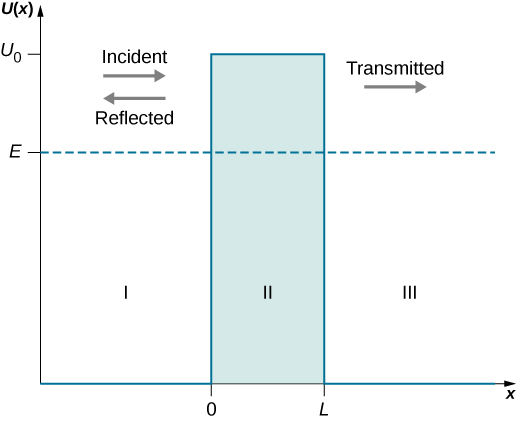| << Chapter < Page | Chapter >> Page > |

When both the width L and the height are finite, a part of the quantum wave packet incident on one side of the barrier can penetrate the barrier boundary and continue its motion inside the barrier, where it is gradually attenuated on its way to the other side. A part of the incident quantum wave packet eventually emerges on the other side of the barrier in the form of the transmitted wave packet that tunneled through the barrier. How much of the incident wave can tunnel through a barrier depends on the barrier width L and its height , and on the energy E of the quantum particle incident on the barrier. This is the physics of tunneling.
Barrier penetration by quantum wave functions was first analyzed theoretically by Friedrich Hund in 1927, shortly after Schrӧdinger published the equation that bears his name. A year later, George Gamow used the formalism of quantum mechanics to explain the radioactive -decay of atomic nuclei as a quantum-tunneling phenomenon. The invention of the tunnel diode in 1957 made it clear that quantum tunneling is important to the semiconductor industry. In modern nanotechnologies, individual atoms are manipulated using a knowledge of quantum tunneling.
Suppose a uniform and time-independent beam of electrons or other quantum particles with energy E traveling along the x -axis (in the positive direction to the right) encounters a potential barrier described by [link] . The question is: What is the probability that an individual particle in the beam will tunnel through the potential barrier? The answer can be found by solving the boundary-value problem for the time-independent Schrӧdinger equation for a particle in the beam. The general form of this equation is given by [link] , which we reproduce here:
In [link] , the potential function U ( x ) is defined by [link] . We assume that the given energy E of the incoming particle is smaller than the height of the potential barrier, , because this is the interesting physical case. Knowing the energy E of the incoming particle, our task is to solve [link] for a function that is continuous and has continuous first derivatives for all x . In other words, we are looking for a “smooth-looking” solution (because this is how wave functions look) that can be given a probabilistic interpretation so that is the probability density.

Notification Switch
Would you like to follow the 'University physics volume 3' conversation and receive update notifications?